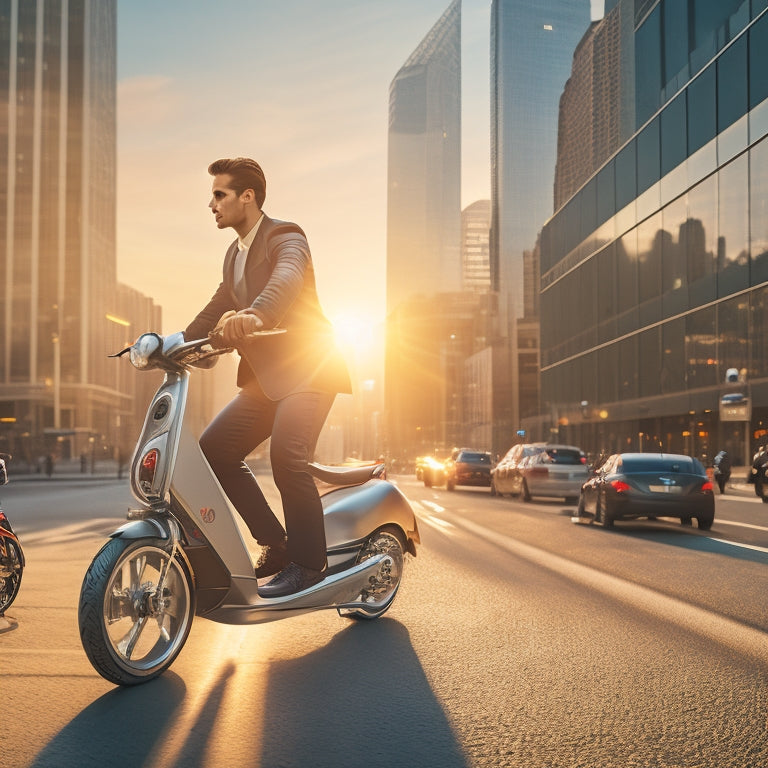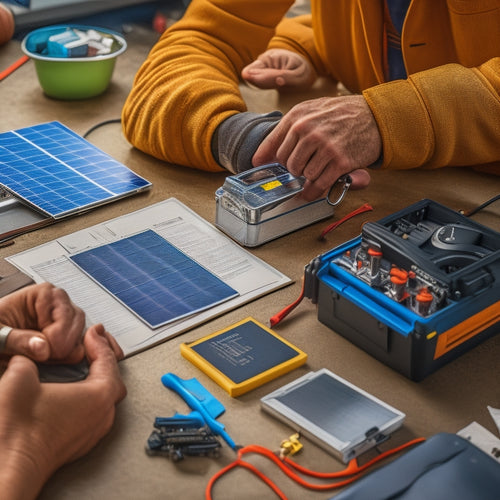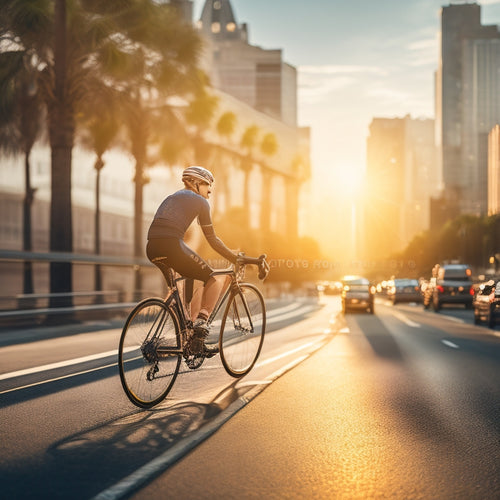
7 Tips for Urban Commuting With Personal Scooters
Share
When commuting with a personal scooter, you'll want to choose the right model for your terrain, wear safety gear always, and plan your route in advance. Follow traffic rules strictly, maintain your scooter regularly, and stay aware of your surroundings. Finally, prioritize visibility in low light conditions. By following these 7 essential tips, you'll be well on your way to a safe, efficient, and enjoyable urban commute. Now, get ready to take your scooter game to the next level with expert tips and tricks that'll have you moving through city streets like a pro.
Key Takeaways
• Consider terrain and scooter features when choosing a model, prioritizing stability, speed, and maneuverability for urban commuting.
• Wear safety gear always, including a helmet, knee pads, elbow pads, and gloves, ensuring a comfortable and snug fit.
• Plan your commute route in advance, using online tools and considering traffic patterns, road closures, and alternative routes.
• Obey traffic rules and practice road discipline, stopping at red lights and stop signs, and yielding to pedestrians.
• Maintain your scooter regularly, checking tire pressure, cleaning and lubricating the chain, and inspecting tire tread for wear patterns.
Choose the Right Scooter Model
When choosing a personal scooter, you'll want to take into account three key factors: terrain, commute distance, and personal preference, as these will help narrow down the numerous scooter models available to find the one that best suits your urban commuting needs.
Considering your terrain is essential, as it affects the scooter's performance. If you'll be riding on smooth, flat surfaces, a lighter scooter with smaller wheels (around 8-10 inches) would be ideal. However, if you'll be traversing rougher terrain, look for a scooter with larger wheels (around 12-14 inches) and a sturdy build to absorb bumps and shocks.
Scooter weight is also important, as it impacts maneuverability and portability. If you plan to take your scooter on public transportation or store it in a small space, a lighter model (under 20 lbs) would be a better fit. Conversely, if you prioritize stability and speed, a heavier scooter might be a better choice.
Wear Safety Gear Always
Before you start your urban commute, strap on a helmet and buckle up with knee pads, elbow pads, and gloves to safeguard yourself against potential accidents and injuries. You never know when you'll need that extra layer of protection.
A helmet is a must, but you can also consider helmet alternatives like a skateboarding helmet or a bike helmet, as long as they meet safety standards. Remember, your safety mindset is key - it's not just about following rules, but about taking responsibility for your own well-being.
When choosing your safety gear, make sure it fits comfortably and snugly. You don't want any distractions or discomforts while traveling through busy streets. Additionally, choose gear that's designed for high-impact activities, as they'll provide better protection in case of an accident.
Plan Your Commute Route
Now that you're geared up with safety equipment, it's time to map out a route that'll get you to your destination efficiently and safely. Planning your commute route is vital to avoid busy streets and reduce your chances of encountering traffic congestion.
Take some time to study the map and identify alternative routes that can help you avoid busy streets. Look for bike lanes, pedestrian paths, or quieter neighborhood streets that can provide a safer and more pleasant commute.
Find alternatives to busy streets by using online route-planning tools or apps that can help you navigate through the city. These tools can provide you with the most efficient route, taking into account traffic patterns, road closures, and other factors that may affect your commute.
Follow Traffic Rules Strictly
As you navigate through the city streets on your personal scooter, remember that obeying traffic rules is important to ensuring your safety and the safety of others around you. Following traffic rules strictly isn't only a legal requirement, but it's also an essential aspect of Traffic Etiquette. By doing so, you'll be practicing Road Discipline, which is crucial for a smooth and safe commuting experience.
You should always follow the same traffic rules as cars, including stopping at red lights and stop signs, and yielding to pedestrians. Make sure you're aware of your surroundings, keeping an eye out for pedestrians, cyclists, and other vehicles.
Use designated bike lanes whenever possible, and always ride in the same direction as traffic. Additionally, be mindful of your speed, especially in areas with heavy pedestrian traffic.
Maintain Your Scooter Regularly
To guarantee your personal scooter runs smoothly and efficiently, you'll need to stay on top of regular maintenance tasks.
You should get into the habit of checking your tire pressure regularly, as underinflated tires can lead to reduced range and stability issues.
Additionally, you'll want to keep your scooter's chain clean and well-lubricated to prevent corrosion and wear.
Tire Pressure Check
You should always check your scooter's tire pressure at least once a week, as important inflation greatly impacts its overall performance, safety, and longevity. Underinflated tires can lead to reduced traction, increased wear, and decreased range, while overinflation can cause uneven tire wear and reduced grip.
To guarantee excellent performance, invest in a reliable pressure gauge and calibrate it regularly to ensure accurate readings. When checking tire pressure, inspect the tire tread as well, looking for signs of wear, uneven wear patterns, or damage. Make a habit of performing a tire tread inspection during your weekly pressure checks.
Proper tire pressure and tread condition can greatly enhance your scooter's stability and responsiveness, making your urban commute safer and more enjoyable. By incorporating this simple yet important maintenance task into your routine, you'll be able to tackle the urban jungle with confidence and style.
Scooter Chain Maintenance
Regular cleaning and lubrication of your scooter's chain can greatly reduce wear and tear, preventing costly repairs and ensuring a smoother ride. A well-maintained chain also helps prevent rust, which can lead to premature wear and even breakage. To keep your scooter running smoothly, make chain maintenance a regular part of your routine.
Here are some tips to keep in mind:
-
Clean your chain regularly:
Use a soft-bristled brush and mild soap to remove dirt and grime. -
Lubricate your chain:
Apply a lubricant specifically designed for chains to reduce friction and wear. -
Check for rust:
Inspect your chain regularly for signs of rust and corrosion.
-
Adjust your chain tension:
Make sure your chain is properly tightened to prevent wear on other scooter components.
Be Aware of Your Surroundings
Riding a personal scooter through urban streets demands constant vigilance, as pedestrians, cars, and other obstacles can suddenly appear in your path. You need to be aware of your surroundings at all times, anticipating potential hazards and reacting quickly to avoid them. This mindful riding approach is essential in urban areas, where the unexpected can happen in a split second.
As you ride, keep an eye out for pedestrians stepping off curbs, cars turning suddenly, or potholes in the road. Stay alert to the sounds around you, like car horns, sirens, or the rustling of leaves that might signal a pedestrian or animal approaching.
Urban awareness is vital to maneuvering busy streets safely and efficiently. You should also be mindful of your own body language and position on the scooter, ensuring you're balanced and in control at all times.
Stay Visible in Low Light
As you ride your personal scooter through the city streets, it's crucial to prioritize visibility, especially during early morning or evening commutes when natural light is scarce.
You'll want to take steps to make sure you're seen by motorists, pedestrians, and other cyclists. By wearing reflective gear, you can greatly enhance your visibility in low-light conditions, reducing the risk of accidents and near-misses.
Be Seen at Night
Your safety on a personal scooter at night largely depends on your ability to be seen by motorists, pedestrians, and other commuters. As you ride through the city streets, it's important to increase your visibility to avoid accidents.
Here are some essential nighttime accessories to boost your evening visibility:
-
Front and rear lights: Install bright, white lights on the front of your scooter and red lights on the rear to make yourself visible from a distance.
-
Reflective decals: Apply reflective stickers or decals on your scooter's frame, wheels, or helmet to reflect light from surrounding sources.
-
LED wheel lights: Wrap LED lights around your scooter's wheels to create a mesmerizing visual effect that's hard to miss.
- Glow-in-the-dark accents: Add glow-in-the-dark strips or accents to your scooter's handlebars, seat, or frame to increase visibility in low-light conditions.
Wear Reflective Gear
By adding reflective gear to your outfit, you can greatly enhance your visibility when commuting at night, making it easier for others to see you from a distance. This is especially important when riding a personal scooter, as you're more vulnerable to traffic hazards.
Incorporate reflective materials into your clothing or accessories to increase your visibility in low-light conditions.
You can opt for visibility accessories like arm or leg bands, ankle straps, or even reflective stickers to add to your helmet or scooter. These reflective materials can be easily integrated into your daily commute attire, providing an extra layer of safety.
Frequently Asked Questions
Can I Use a Personal Scooter on Highways and Interstates?
Oh, you think you can just hop on your scooter and hit the highway? Please don't. You'll get flattened. Highway rules are strict, and speed limits are way too high for your tiny scooter - it's just not safe, sweetie.
How Do I Lock and Secure My Scooter When Parked?
When parking, you'll want to secure your ride. Invest in scooter anchors or chain locks to keep your scooter in place. Opt for parking spots with built-in wheel clamps or consider adding immobilizers for extra protection.
Are There Designated Scooter Parking Areas in Cities?
You'll often find designated scooter parking areas, like scooter corrals, in urban planning, especially in bike-friendly cities, making it easier for you to lock up and stash your ride while you're out and about.
Can I Ride My Scooter on Sidewalks and Bike Paths?
Riding your scooter on sidewalks and bike paths is like managing a relationship - it's all about shared spaces and respect. Check local ordinances, as some allow it, while others prioritize pedestrian safety, urban planning, and infrastructure design.
Are Personal Scooters Allowed in Public Transportation Vehicles?
When you plan to take public transportation, you'll need to check the vehicle policy of your local transit system, as bus restrictions and train regulations vary, affecting station access with your scooter.
Related Posts
-

7 Essential Tips for DIY Solar Car Battery Install
To guarantee a successful DIY solar car battery installation, you'll need to choose the right components and follow p...
-

Why Go Solo in Urban Transportation?
You're taking control of your daily commute by ditching the crowds and going solo, and that's a smart move. By choosi...
-

What Eco-Friendly Vehicles Can You Buy Online Today?
You can now browse and buy a wide range of eco-friendly vehicles online, from electric cars with solar roofs to solar...


